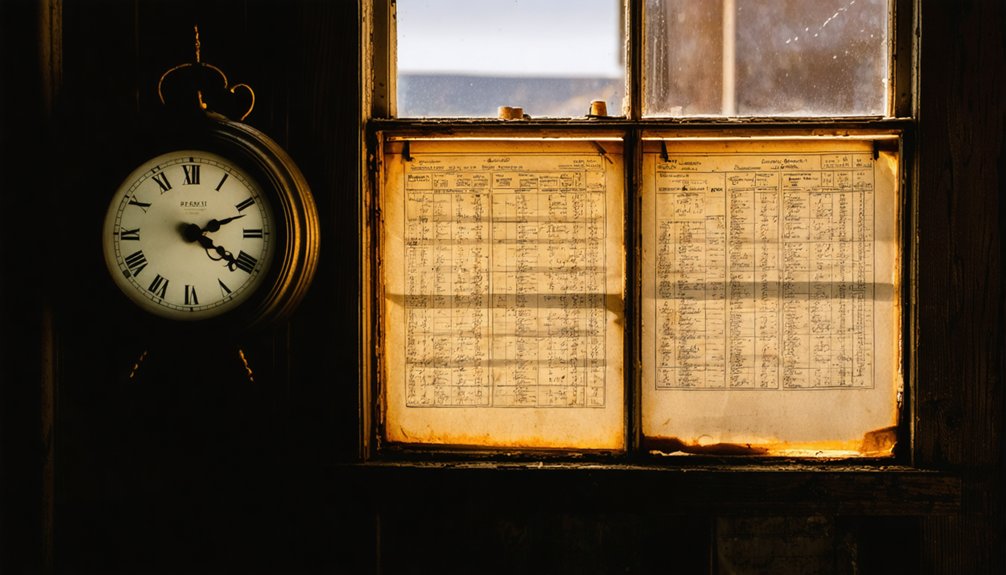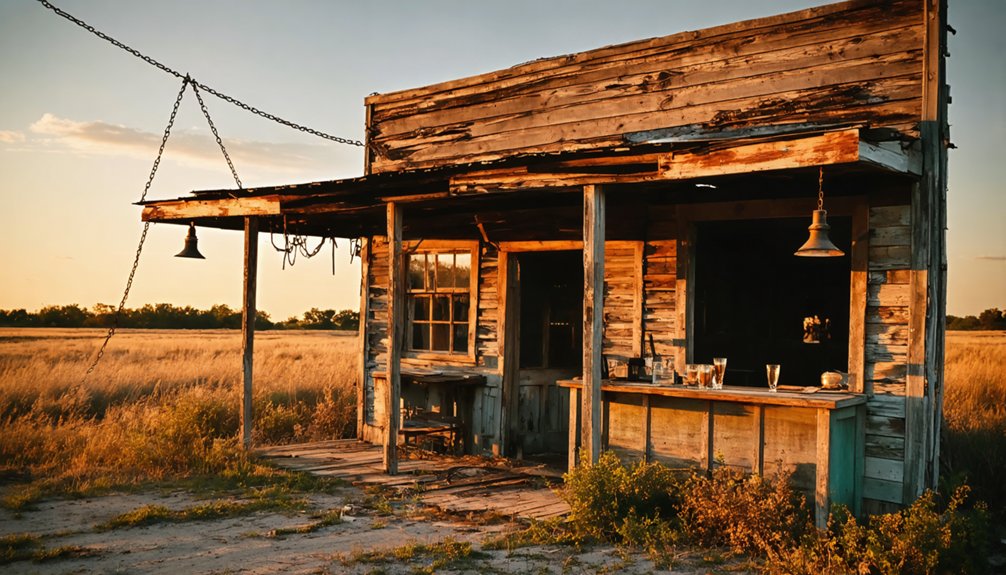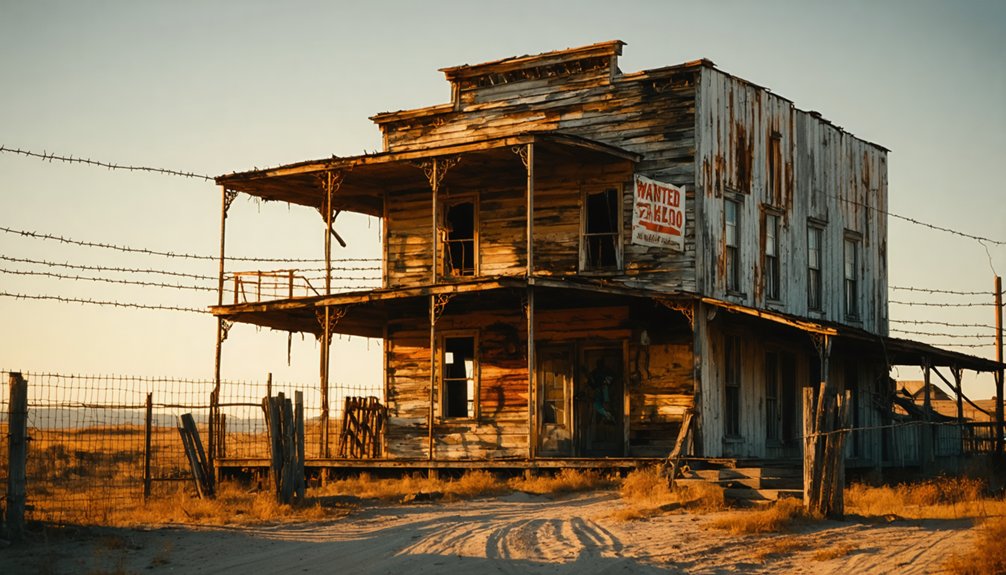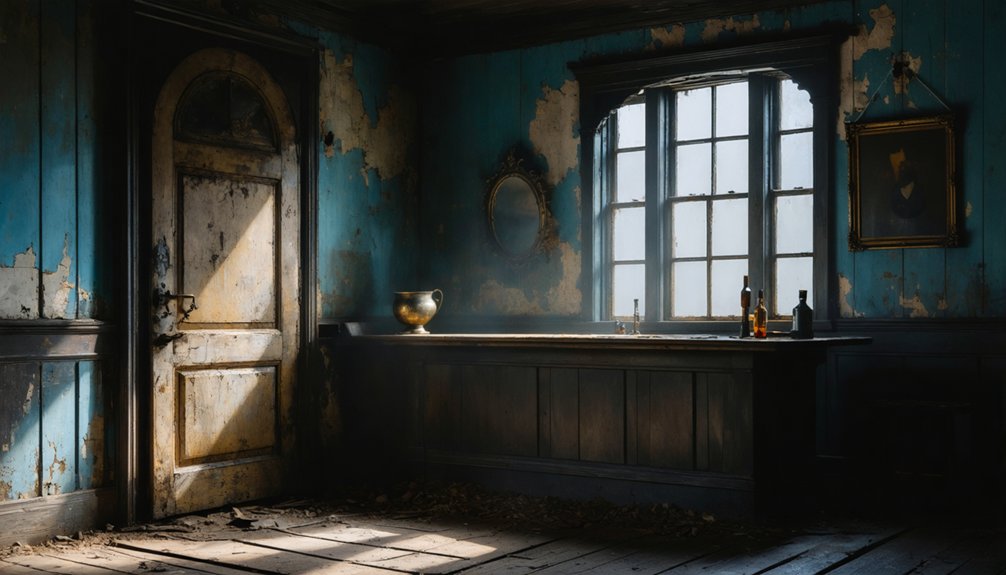Texas ghost towns harbor America’s most perplexing mass disappearances. You’ll discover Shackelford County’s alleged overnight exodus, Terlingua’s vanished mercury miners, and Indianola’s hurricane-erased port city. Jefferson’s riverport collapse, Paducah’s intact yet abandoned townscape, Barstow’s railroad bypass, and Independence’s post-war desertion round out these haunting mysteries. Behind each crumbling facade and empty street lies an untold story of sudden departure that continues to baffle historians and paranormal investigators alike.
Key Takeaways
- Terlingua’s mercury mines contain tales of miners who vanished in shafts, with over 430 unidentified graves surrounding the town.
- Shackelford County allegedly experienced an overnight exodus of residents, though historians attribute the decline to gradual economic forces.
- Paducah’s buildings remain eerily intact despite residents mysteriously vanishing after surviving natural disasters in the late 1800s.
- Jefferson transformed from a bustling riverport of 7,000 people to a ghost town after the Great Red River Raft was destroyed.
- Indianola’s population persisted after losing 75% of buildings in an 1875 hurricane but vanished completely after the catastrophic 1886 storm.
The Overnight Exodus of Shackelford: A Golden Mystery
While the dust-stained records of 1874 show Shackelford County’s official birth from the lawless territories of Jack County, they reveal nothing about the most haunting aspect of its story—the alleged vanishing of its people.
You’ll find nothing in official documents confirming the overnight exodus that dominates Shackelford folklore. This settlement, once known as “Babylon on the Brazos,” didn’t suddenly empty—despite what ghost town enthusiasts might tell you.
The decline was gradual, tied to the fading frontier lawlessness as martial law tamed the wild settlement beneath Fort Griffin. Similar to Cheapside, Texas, the community experienced a gradual decline over decades rather than a sudden disappearance.
The myth persists because it’s more intriguing than reality. No mysterious event drove everyone away at once. Instead, economic forces—bypassed railroads, shifting markets, and the westward movement of opportunity—slowly drained the lifeblood from this once-notorious Texas community, leaving only scattered ruins to feed our imagination. When the Texas Central Railroad bypassed Fort Griffin in favor of Albany, it accelerated the town’s inevitable decline.
Terlingua’s Mercury Miners: Whispers From the Abandoned Shafts
You’ll find Terlingua’s abandoned mercury shafts still whispering tales of miners who vanished without trace, their disappearances obscured by the quick onset of mercury poisoning that claimed countless lives within five years of exposure.
Ghostly figures reportedly guide lost explorers through the sprawling tunnel networks, a chilling indication to over 430 unidentified graves that surround the once-bustling mining town.
These spectral miners, victims of Chisos Mining Company’s profit-driven operations, continue their eternal shifts beneath the Texas desert, where moonlight occasionally reveals their silhouettes near collapsed mine entrances that once produced quicksilver for America’s war machine. The demand for mercury peaked dramatically during both World Wars, when miners extracted significant ore quantities under dangerous conditions to meet military requirements.
Visitors exploring the canyon near Turling often report strange echoes that sound like mining tools, reminiscent of the town’s Quicksilver mining era that sustained the population before its decline.
Quicksilver’s Deadly Legacy
Beneath the parched Chihuahuan Desert soil, Terlingua’s abandoned mercury mines harbor more than just toxic remnants of a forgotten industry—they’ve become vessels for the whispers of those who never emerged from the darkness.
You’d shudder at the quicksilver dangers that plagued these tunnels. Most miners lasted fewer than five years before tremors, neurological breakdown, and respiratory failure claimed them. The Chisos Mining Company extracted profits while workers extracted poison.
When the mines flooded in 1946, they sealed both ore and secrets underground. The extensive underground workings totaled 23 miles of tunnels and shafts by the time operations ceased.
Miner folklore tells of spectral figures who guide lost wanderers through labyrinthine shafts, perhaps seeking justice for their abbreviated lives. The cemetery, dotted with markers from the early 1900s, stands as a witness to mercury’s invisible assault. The influenza pandemic of 1918-1919 further swelled the cemetery’s population, adding to the toll already taken by the harsh mining conditions.
Those 2,000 souls who once called Terlingua home left behind both their bodies and their spirits.
Moonlit Mine Apparitions
Many Terlingua residents have witnessed the pale blue apparitions that materialize near abandoned mine entrances during the quarter moon phases, when atmospheric conditions mirror those of the fateful 1914 tunnel collapse that claimed seventeen miners.
You’ll find these ghostly echoes most prevalent along the 23-mile network of underground shafts that honeycomb the limestone beneath your feet.
Mexican nationals who fled revolution only to perish in Perry’s profitable cinnabar empire now manifest as miner spirits wandering the former tramway path.
Locals report hearing Spanish whispers emanating from metal-grated shaft openings, particularly near the Scott Furnace installation where mercury vapors once billowed.
The phenomena intensified after 1946 when artesian waters flooded the tunnels, seemingly awakening those trapped forever in Chisos Mining Company’s subterranean labyrinth. The town’s transition to a ghost town status following the company’s bankruptcy in 1942 created the perfect conditions for these supernatural occurrences.
The cemetery with its approximately 530 graves stands as a silent witness to these paranormal activities, with unidentified souls potentially contributing to the spectral phenomena.
Indianola: How Two Hurricanes Erased a Thriving Port
While the waters of Matagorda Bay now silently flow over what was once a bustling commercial center, Indianola’s tragic tale begins with extraordinary promise.
You’re witnessing the spectral remnants of a port where 5,000 souls once thrived, their collective ambitions swept away by nature’s fury. Before disaster struck, the town served as a crucial hub for U.S. Army supplies during the Civil War. Indianola’s resilience manifested after the 1875 hurricane destroyed 75% of buildings, yet half its population refused to abandon their maritime dreams. The town originally established in 1844 became a major entry point for European immigrants heading to West Texas.
Three fateful elements sealed Indianola’s doom:
- The catastrophic 1886 category 4 hurricane that left only two structures standing
- A massive fire that consumed what little remained of the port infrastructure
- The subsequent submersion of its courthouse foundations and main streets beneath rising waters
Jefferson’s Silent Decline: From River Port Glory to Haunted History
You’re walking through a town that once rivaled New Orleans as the Southwest’s preeminent riverport until Captain Henry Miller Shreve’s explosive clearing of the Red River raft in 1873 catastrophically lowered water levels and severed Jefferson’s commercial lifeline.
What you’ll discover is an accidental preservation project—Victorian structures frozen in time not through careful conservation but through economic collapse that prevented modernization from erasing the past.
Now this eerily preserved 19th century landscape fuels a paranormal tourism economy where twice-yearly ghost hunting conferences and documented hauntings sustain a town that refused to completely vanish despite its waterways running dry.
Riverboat Commerce Collapse
Deep beneath the surface of Jefferson’s haunted legacy lies a story of environmental engineering gone awry—a tale where human intervention against nature sealed a once-thriving port’s fate.
You’re witnessing the aftermath of prosperity vanishing overnight when the Army Corps of Engineers detonated nitroglycerin charges into the Great Red River Raft in 1873, triggering catastrophic riverboat decline.
For six centuries, this natural logjam had:
- Created a deep-water basin making Jefferson Texas’s westernmost navigable port
- Enabled transportation of 75,000 cotton bales annually through a natural lock system
- Established Jefferson as the state’s second-largest trading center after Galveston
The sudden environmental collapse brought economic devastation more complete than any supernatural curse—transforming a bustling city of 7,000 into a ghost town whose empty docks still whisper of vanished fortunes.
Historic District Preservation
Jefferson’s economic collapse birthed an eerie architectural afterlife—a town frozen in time rather than demolished by progress.
You’ll find nearly 100 historical landmarks haunting Jefferson’s boundaries, most listed on the National Registry, with 56 buildings of state significance anchoring the Historic District.
While local ordinances attempt to prevent unauthorized modifications within designated historic boundaries, Jefferson lacks Certified Local Government status or integration into broader preservation programs.
The Jessie Allen Wise Garden Club initiated restoration efforts in 1941, fighting against decades of arson, vandalism, and deterioration.
The town’s architectural integrity survives through community persistence rather than robust historic preservation frameworks.
Greek Revival structures silently testify to vanished prosperity, while recent survey grants of $249,913 represent belated attempts to catalog the spectral remains of Jefferson’s architectural legacy.
Paranormal Tourism Phenomenon
When the last nitroglycerin charge silenced the Red River in 1873, it unintentionally birthed what would become “the most haunted town in Texas.”
As the waters receded from Big Cypress Bayou, so did Jefferson’s economic lifeblood, leaving behind architectural ghosts that now draw a peculiar breed of tourist.
You’ll find Jefferson’s transformation from commercial hub to paranormal hotspot follows a curious pattern:
- Nearly 100 historical landmarks now host reported ghostly encounters, many listed on the National Registry.
- Former merchant buildings transformed into bed-and-breakfasts featuring haunted landmarks.
- The economic vacuum created by the 1873 catastrophe preserved Victorian architecture that now forms the backbone of spectral tourism.
Where steamboats once delivered prosperity, ghost hunters now arrive seeking evidence of restless spirits trapped in Jefferson’s arrested development.
The Unexplained Desertion of Paducah’s Intact Townscape
Among the numerous ghost towns dotting the Texas landscape, Paducah stands as a particularly unsettling anomaly—a town where time appears to have simply stopped.
What makes Paducah’s abandonment so perplexing is that many buildings remain fully inhabitable, preserved in eerie suspended animation.
You’ll find a complete townscape—cafes, stores, and even the White Sanatorium (a former mental hospital)—all abandoned yet structurally intact.
After surviving devastating hurricanes and fire in the late 1800s, followed by decades of economic decline, residents simply vanished.
Visitors report ghostly sightings of tall, thin shadows and unexplained whispers echoing through empty streets.
Poor railroad planning and the northwest Texas location accelerated the desertion, yet the town’s perfect preservation raises questions no historian has fully answered.
The buildings wait, as if their inhabitants might return any moment.
Barstow: When the Railroad Passed By, Time Stood Still

In the arid expanse of West Texas, Barstow stands as a haunting symbol of how quickly prosperity can evaporate when essential lifelines are severed.
You’ll find only ghosts of former ambition where the Texas and Pacific Railway once brought life before railroad rerouting diverted commerce elsewhere.
The town’s fate was sealed by a devastating one-two punch:
- The breaking of the Pecos River dam in 1904
- Poisoned crops from mineral-heavy irrigation water
- The agricultural disaster of the 1910 drought
If you’re brave enough to visit, you might glimpse the robed specters locals claim float silently above the ground—silent witnesses to Barstow’s abandonment.
Founded by ambitious Rhode Islander George Barstow, this once-thriving county seat now crumbles back into the desert, its population dwindling toward extinction.
Independence: A College Town’s Mysterious Post-War Disappearance
The cotton kingdom of Independence still whispers tales of its grandeur, unlike Barstow’s railway-dependent decline.
While other towns crumbled with the railways, Independence’s cotton legacy echoes through its abandoned grandeur.
You’ll find this once-prosperous community—founded in 1835 and renamed to commemorate Texas freedom—now haunts the countryside with merely 4-5 residents.
While natural disasters conspired against it (the 1873 fire, 1882 tornado, and devastating hurricanes), the town’s true demise came through a single fateful decision.
When leaders refused Santa Fe Railroad’s right-of-way, they unwittingly triggered Baylor University’s 1886 departure to Waco, severing Independence’s college legacy.
The economic decline unfolded not as sudden vanishing but as century-long attrition.
Now, only four majestic columns from Baylor’s original campus stand sentinel over empty streets where 424 souls once thrived, their gradual disappearance an unsolved mystery of ambition and isolation.
Frequently Asked Questions
Are There Dangerous Wildlife Encounters in These Abandoned Ghost Towns?
Yes—you’ll face rattlesnakes, mountain lions, and feral hogs within ghost town ecosystems. Wildlife safety demands vigilance as predators prowl these forgotten domains, especially during spring’s mysterious awakening.
Can Visitors Legally Remove Artifacts From These Historic Sites?
Would you risk your freedom for fleeting treasure? You can’t legally remove artifacts from these sites. Artifact preservation is mandated by state and federal laws, with serious legal ramifications for unauthorized collection.
What Is the Best Season to Experience Paranormal Activity?
Autumn whispers your name as spectral energies peak between fall equinox and Halloween. Unlike summer solstice’s diminished veil, October’s darkening days create perfect conditions for encountering what lingers beyond our perception.
Are Any Ghost Towns Currently Inhabited by Off-Grid Communities?
Yes, you’ll find off-grid living thriving in several Texas ghost town communities like Terlingua, Helena, and Mobeetie, where resilient souls harness alternative energies amidst historical ruins, defying conventional boundaries of civilization.
How Have Native American Tribes Responded to Ghost Hunting Tourism?
Where ancestral spirits rest, tread lightly. You’ll find Native tribes often resist ghost hunting tourism, emphasizing tribal perspectives on sacred spaces and prioritizing cultural preservation over paranormal entertainment that commodifies their spiritual connections.
References
- https://www.houstononthecheap.com/ghost-towns-in-texas-abandoned-places-getaway-from-houston/
- https://www.youtube.com/watch?v=Zd8-gKw-5Hc
- https://www.worldatlas.com/cities/visit-these-9-creepy-ghost-towns-in-texas.html
- https://www.youtube.com/watch?v=bbVM_-giQIE
- https://www.legendsofamerica.com/tx-ghosttowns/
- https://www.youtube.com/watch?v=DRn0IjjUpOw
- https://www.onlyinyourstate.com/experiences/texas/unsolved-mysteries-tx
- https://www.youtube.com/watch?v=3Pj6U6sDAso
- https://texashighways.com/travel/the-quest-to-resurrect-a-ghost-town/
- https://www.youtube.com/watch?v=PAF6bbJQqYo



